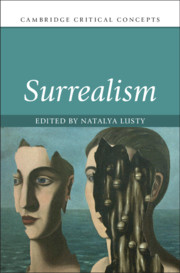Book contents
- Surrealism
- Cambridge Critical Concepts
- Surrealism
- Copyright page
- Contents
- Illustrations
- Notes on Contributors
- Acknowledgments
- Introduction: Surrealism’s Critical Legacy
- Part I Origins: Ideas/Concepts/Interventions
- Part II Developments: Practices/Cultures/Material Forms
- Chapter 7 Surrealist Collections in Paris and Sussex
- Chapter 8 Surrealist Objects
- Chapter 9 Collage
- Chapter 10 Film
- Chapter 11 Photography in Surrealism
- Chapter 12 Surrealist Fashion
- Chapter 13 Surrealist Display Practices
- Part III Applications: Heterodoxies and New Worlds
- Select Bibliography
- Index
Chapter 12 - Surrealist Fashion
from Part II - Developments: Practices/Cultures/Material Forms
Published online by Cambridge University Press: 23 July 2021
- Surrealism
- Cambridge Critical Concepts
- Surrealism
- Copyright page
- Contents
- Illustrations
- Notes on Contributors
- Acknowledgments
- Introduction: Surrealism’s Critical Legacy
- Part I Origins: Ideas/Concepts/Interventions
- Part II Developments: Practices/Cultures/Material Forms
- Chapter 7 Surrealist Collections in Paris and Sussex
- Chapter 8 Surrealist Objects
- Chapter 9 Collage
- Chapter 10 Film
- Chapter 11 Photography in Surrealism
- Chapter 12 Surrealist Fashion
- Chapter 13 Surrealist Display Practices
- Part III Applications: Heterodoxies and New Worlds
- Select Bibliography
- Index
Summary
This chapter offers an overview of significant surrealist treatments of fashion and style, focusing in particular on the design work of Elsa Schiaparelli as well as on Salvador Dalí’s designs for fabrics, accessories, and department store windows. The chapter examines fashion as a site for the popular translation of surrealist tropes, through advertising, print media, and retail display, and suggests that the precarious cultural positioning of fashion as both art and commerce was deeply related to the long-standing critique of surrealism’s commodification. It further argues that foregrounding fashion in the surrealist archive has implications for understanding the role of women and femininity in surrealism. The visual ubiquity of surrealist tropes in the interwar and the early post–Second World War period ensured that women’s bodies were positioned as expressive agents in close proximity to surrealist tropes, though it thus bound women closely with the movement’s commodification.
- Type
- Chapter
- Information
- Surrealism , pp. 224 - 239Publisher: Cambridge University PressPrint publication year: 2021

